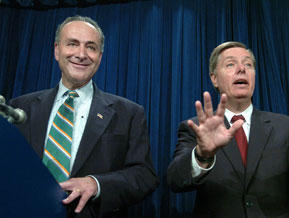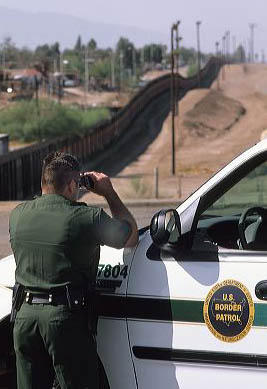Not long ago, I was talking with a friend and neighbor who happens to be an unauthorized immigrant. She raised the topic of the then-upcoming presidential election and asked me who I thought had been a good president of the United States. As I struggled to formulate a response, she volunteered the name of a former president she much admired: Ronald Reagan.
As I gasped to myself at the name of the person responsible for sowing so much terror in Central America in the 1980s—among other myriad crimes and injustices that he perpetrated—she explained why: “He gave amnesty to undocumented immigrants.” 
Indeed, Reagan (and the Congress) did just as my friend stated. Reagan signed into law the Immigration Reform and Control Act (IRCA) in November 1986. IRCA made eligible for permanent residency (and eventual citizenship) unauthorized migrants who had lived in the United States continuously since at least January 1, 1982, as well as those who had labored as agricultural workers for at least 90 days in a one-year period beginning on May 1, 1985. An estimated three million individual eventually benefitted from this program.
I recalled the conversation with my friend on the Sunday following Obama’s re-election when it became clear that the corpse of comprehensive immigration reform had risen from the dead. On the talk show “Meet the Press,” Senator Charles “Chuck” Schumer (Democrat-New York) told host David Gregory that he and Senator Lindsay Graham (Republican-South Carolina) were resurrecting talks broken off two years earlier to finalize a reform plan that will win bipartisan support.
While “comprehensive immigration reform” means many things to many people, in Washington circles the range of what it signifies is pretty narrow: 1) more “security” and policing—along the country’s perimeter and within; 2) an expansion of employment-related (temporary) immigration; and 3) a long path to regularization of status and, eventually, citizenship for many, but far from all, of the millions of unauthorized migrants living in the United States. Thus, as Schumer explained, his and Graham’s “detailed blueprint” has these components:
First of all, close the border, make sure that’s shut. Second, make sure that there is a non-forgeable document so that employers can tell who was legal and who was illegal. And once they hire someone illegally, throw the book at them. . . . . that will stop illegal immigration in its tracks. Third, on legal immigration, let in the people we need, whether they be engineers from our universities, foreign or people to pick the crops. And fourth, a path to citizenship that’s fair, which says you have to learn English, you have to go to the back of the line, you’ve got to have a job, and you can’t commit crimes.
There are many troublesome aspects of the Schumer-Graham plan in terms of what it embodies and suggests. But the refusal to embrace something Ronald Reagan championed not too long ago (in, among other venues, a presidential debate with Democratic candidate Walter Mondale in 1984—see below) is perhaps the most painful manifestation of how much the political spectrum has moved in a direction of immigration restriction.
So instead of a general amnesty—or whatever one might want to call it—for those living in the United States without legal status, what is on offer is far more limited. By invoking the highly elastic c ategory of crime, Schumer and Graham are undoubtedly casting aside large numbers of unauthorized migrants who might otherwise be eligible to walk down that “path to citizenship.” (Like Obama’s record-setting deportation regime, this delimitation of eligibility also sets the stage for ever-more divided families.)
ategory of crime, Schumer and Graham are undoubtedly casting aside large numbers of unauthorized migrants who might otherwise be eligible to walk down that “path to citizenship.” (Like Obama’s record-setting deportation regime, this delimitation of eligibility also sets the stage for ever-more divided families.)
What percentage of people would be denied is unclear. However, given the ever-expansive category of crime and its highly elastic nature, the qualifications uttered by Schumer are certainly cause for great worry. This is not least because the very “illegal” status of unauthorized immigrants often compels them to violate the law—by using false documents to secure employment, for example, or to participate in the “underground” or illicit economy to survive. They also often live in low-income, heavily policed communities in which the likelihood of arrest for all sorts of activities that many people in the United States regularly engage in is greatly heightened.
Ronald Reagan played a huge role in bringing about this draconian law-and-order regime. Yet, as Jerry Bowyer recently wrote in criticizing present-day conservatives (a criticism also applicable to most Democrats these days), “Reagan had a completely different idea about immigration and the border from the wall/moat/electrocution/drone model. His diaries show an emotional discomfort with militarized borders with Mexico. He met with the President of Mexico to try to discuss ways to do something better with the border then to turn it into a fence.”
In praising Reagan as he does, Bowyer reminds just how much the debate has shifted since the 1980s. Yet, he also misrepresents the historical record in a number of important ways.
Reagan and his administration often framed unauthorized immigration as an issue of national security, while working to build support for “regaining control of our borders.” As “the Great Communicator” warned in 1984, ”The simple truth is that we've lost control of our borders and no nation can do that and survive.”
Moreover, Reagan justified his administration's imperialistic policies in Central America on the basis of stemming the influx of refugees into the United States. As sociologist Timothy Dunn has written, Reagan contended that if Congress did not approve aid to counterrevolutionary forces in the region there would be “a tidal wave of refugees—and this time they'll be ‘feet people’ and not boat people—swarming into our country seeking safe haven from communist repression to our south.”
refugees into the United States. As sociologist Timothy Dunn has written, Reagan contended that if Congress did not approve aid to counterrevolutionary forces in the region there would be “a tidal wave of refugees—and this time they'll be ‘feet people’ and not boat people—swarming into our country seeking safe haven from communist repression to our south.”
In framing matters as he did, Reagan helped lay much of the ideological foundation for the massive build-up in immigration and boundary enforcement that has unfolded over the last two decades or so. Indeed, federal funding, and the amount and quality of immigration enforcement-related infrastructure and equipment grew substantially during Reagan’s two terms—much of it justified in the name of the disastrous war on drugs. Moreover, it was through IRCA that the criminalization of employment of unauthorized migrants first became law.
Still, it is important to remember that the power of the state—materially and ideologically—in regards to immigration and the borderlands was dramatically less than it is today. To give just one example, there were about 3,700 U.S. Border Patrol agents at the end of Reagan’s second term in office. Today, there are close to 22,000.
Thus, when Schumer and Graham talk about “closing” the border, it is imperative to keep in mind that the federal government’s capacity to police the country’s boundaries and interior, to exclude, detain, deport, and divide families is vastly superior to what it was less than 30 years ago when IRCA came into being, far greater than Ronald Reagan could have probably even imagined.
It is for this reason and many more that the advocates of the rights of immigrant and border communities need to be extremely wary about talk of comprehensive immigration reform given that it embraces the very enforcement buildup (and more of it) that has been so damaging to immigrant families and communities.
The way it looks now, were “reform” to pass today, it would mimic IRCA to the extent that it would contain both a "carrot" in the form of legalization for (some of) those already in the United States and a "stick" in the form of ever more formidable enforcement at the border and within. But this time, the carrot will be far less generous than it was in 1986, and the punishment of the stick and the larger apparatus of exclusion will be a lot stronger.
In this regard, progressive advocates need to exert great caution to avoid sacrificing long-term changes for short-term gains. Imagining something far better than the old poison in Schumer’s and Graham’s new bottle is a key step in doing so.
Joseph Nevins teaches geography at Vassar College in Poughkeepsie, New York. Among his books are Dying to Live: A Story of U.S. Immigration in an Age of Global Apartheid (City Lights/Open Media, 2008) and Operation Gatekeeper and Beyond: The War on “Illegals” and the Remaking of the U.S.-Mexico Boundary (Routledge, 2010). For more from the Border Wars blog, visit nacla.org/blog/border-wars. Now you can follow it on Twitter @NACLABorderWars.

